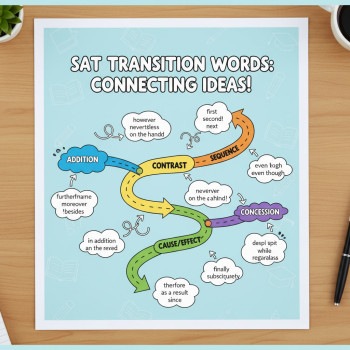Why timing is the quiet hero of SAT success
When you think about SAT prep, you probably picture content review, flashcards, and full-length practice tests. All of those matter. But there’s another player that quietly decides whether that knowledge translates into a great score: timing. How you use the minutes in each section can be the difference between a wasted correct instinct and a right answer on test day.
Timing isn’t just about rushing. It’s about rhythm, decision-making under pressure, and strategic distribution of effort. In this post, we’ll zoom in on how section timing affects practice outcomes, give concrete pacing strategies for each section, show drills you can use, and share a week-by-week plan to rewire your timing habits. You’ll also see how targeted, personalized help — like Sparkl’s 1-on-1 guidance and AI-driven insights — can accelerate your progress when timing is the bottleneck.
Know the ground rules: SAT timing at a glance
Before we dig into strategies, let’s get the facts straight. The SAT (without the optional essay) runs for 180 minutes total, split into four scored sections. Here’s a practical breakdown:
| Section | Time | Questions | Average time per question (approx) |
|---|---|---|---|
| Reading | 65 minutes | 52 | ~75 seconds |
| Writing & Language | 35 minutes | 44 | ~48 seconds |
| Math — No Calculator | 25 minutes | 20 | ~75 seconds |
| Math — Calculator | 55 minutes | 38 | ~87 seconds |
These averages are useful, but sections don’t divide neatly by question. Reading involves passages, Writing & Language groups questions by passage, and Math mixes straightforward computation with more complex multi-step problems. That means smart pacing adapts to structure, not just per-question averages.
Why timing matters to practice outcomes
Think of timing as a lens that reveals the difference between knowing content and using it under pressure. Here’s how timing directly impacts practice outcomes:
- Accuracy under pressure: Practicing with clocks recreates the psychological pressure of the test. Your error pattern changes under time constraints — and that’s where real improvement must happen.
- Strategic question selection: Time-aware practice teaches you when to skip, when to guess, and when to dig deeper. Because there’s no penalty for wrong answers, the right decision is often to move on and return if time allows.
- Stamina and pace management: The SAT is a long test. Pacing during the first section affects energy later. If you sprint early, you may tire and lose accuracy in final sections.
- Reliable score projections: Untimed practice inflates confidence. If you only practice untimed, you won’t know whether your accuracy holds when the clock is on, and your practice test scores will mislead you.
Section-by-section timing strategies
Reading — Make each passage count
Reading offers 65 minutes for 52 questions across 4–5 passages. Many students read either too slowly or too quickly. The middle ground is a steady passage-based rhythm.
- Target about 13 minutes per passage. That includes reading and answering 10–12 questions. Some passages (paired) have more questions, so adapt.
- Use a two-pass method when you’re starting: quick read for main idea and evidence, answer easy questions first, then return to detail questions. As you improve, try a targeted read where you skim for structure and then annotate while seeking answers.
- Mark and move: If a question is taking too long, mark it and move on. Coming back with fresh perspective often saves time.
Writing & Language — Hunt patterns, not words
With 35 minutes for 44 questions across four passages, this section rewards pattern recognition and swift grammar instincts.
- Think in terms of 8–9 minutes per passage. That’s a short window, so prioritize grammar patterns and rhetorical logic.
- Train yourself to spot commonly-tested grammar rules: subject-verb agreement, verb tense shifts, pronoun clarity, and concision. The faster you recognize a rule, the quicker you answer.
- Read the underlined portion and the surrounding sentence or paragraph quickly; avoid re-reading whole paragraphs unless you suspect a rhetorical issue.
Math — Mix speed with selective depth
Math has two parts. No Calculator gives 25 minutes for 20 questions; Calculator gives 55 minutes for 38 questions. You’ll need speed for simpler questions and patience for multi-step problems.
- For No Calculator, aim for about 75 seconds per question. Expect straightforward algebra and arithmetic; practice mental math and neat setup techniques.
- For Calculator, average time per question is close to 87 seconds, but distribute your time: take less on the easiest problems to bank time for hard ones.
- Adopt a problem triage. If a question looks like a multi-variable mess, flag it, solve the next 2–3 questions, and then return with a fresh approach.
- Use scratch work effectively. Clear notation and small diagrams prevent wasted time from backtracking.
Two contrasting case studies — timing in action
Concrete examples make theory stick. Here are two short stories from practice rooms that capture timing’s power.
Emma: the perfectionist who ran out of time
Emma knew every grammar rule and could solve algebraic systems quickly on a whiteboard. But in timed practice she often slowed to check every answer twice. In the Reading section she would linger on a single detail question for nearly five minutes, losing the rhythm for the rest of the passages. Her practice scores were inconsistent: high accuracy when untimed, but lower when timed.
Solution: Emma worked on strict per-passage checkpoints and used timed micro-drills that forced her to move on after 13 minutes. She also practiced the habit of placing a mark next to a tricky question and returning if time allowed. Over six weeks, her timed accuracy increased and her overall score rose by nearly a hundred points.
Jay: the fast finisher who sacrificed accuracy
Jay zipped through questions, proud of finishing early. But finishing fast didn’t mean finishing well. Rushing led to avoidable mistakes: misreading a sign change in math, or picking an answer that seemed to match a phrase but contradicted the passage’s tone.
Solution: Jay introduced a stopping rule: for Reading, spend the first 55–60 minutes on the first four passages and reserve the final 5–10 minutes for review. For Math, he slowed slightly on algebraic manipulations to cut down careless errors. Over time his speed settled into an efficient pace and his score improved.
Timed drills that meaningfully shift outcomes
Not all timed practice is equally productive. Below are drills designed to teach specific timing skills:
- 13-minute passage drill: Pick a reading passage and answer all questions in exactly 13 minutes. No re-reading allowed. Focus on efficient annotation.
- 8-minute writing passage sprint: Complete a Writing & Language passage in 8 minutes to train rapid grammar spotting.
- 10-question math burst: Choose 10 mixed math questions and solve them in 12 minutes, emphasizing correct setups and avoiding long algebraic manipulations when shortcuts exist.
- Checkpoint full section: Take a full section with prescribed checkpoints. For example, stop after 25 minutes in Reading to see how many passages you’ve completed and adjust for the next block.
- Simulated fatigue test: Take the final section after doing a different intense task (a different practice test section or a high-energy activity). This trains concentration under tiredness.
How to measure progress beyond raw scores
Timed practice needs measurable feedback. Don’t only look at overall test scores. Track these metrics:
- Average time per question by question type (e.g., Evidence vs. Detail in Reading, Grammar vs. Rhetorical in Writing).
- Number of flagged questions per section and percent answered correctly when returned to.
- Stamina curve: accuracy by section order across a full-length practice test (do you drop in the last section?).
- Finish time distribution: how often do you finish early, on-time, or late for each section?
Tools that visualize these metrics can speed learning. For example, a tutor or platform that offers AI-driven insights can analyze which pacing choices cost you points and recommend targeted drills. Sparkl’s personalized tutoring blends expert tutor feedback with AI insights to identify precise timing weak spots and design tailored study plans.
Common timing mistakes and quick fixes
- Mistake: Treating every question the same. Fix: Use triage — easy, medium, hard — and allocate time accordingly.
- Mistake: Ignoring the structure of the section (reading by passage, writing by passage). Fix: Practice at the passage level and set passage time targets.
- Mistake: Rushing review or skipping it entirely. Fix: Build in a 3–5 minute checkpoint at the end of a section to check flagged items if possible.
- Mistake: Practicing untimed for too long. Fix: Move to timed practice early and use untimed review only to fix conceptual gaps.
Sample 8-week plan to rewire your timing habits
This is a practical schedule you can adapt. It assumes 6–10 hours per week of focused prep.
- Weeks 1–2: Baseline timed sections. Identify weakest section. Do section-specific micro-drills (13-minute reading, 8-minute writing, 10-question math bursts). Track time per question.
- Weeks 3–4: Introduce two full timed sections per week and one full-length timed test on week 4. Begin checkpoint discipline: preset minute markers to evaluate pacing mid-section.
- Weeks 5–6: Increase specificity. For each mistake category, run 15–20 minute targeted drills. Add simulated fatigue tests and review your stamina curve. If you work with a tutor, refine pacing with guided feedback.
- Weeks 7–8: Polish and simulate test day. Full-length tests under real conditions. Focus on consistency rather than last-minute content cramming. Keep sleep, nutrition, and timing rituals consistent.
Practical tools and rituals to lock in good pacing
Small routines make a big difference on test day.
- Use a visible, silent timer during practice. Learn to check it without losing focus.
- Create a marking code: one symbol for “hard, skip and come back,” another for “double-check.”
- Practice the physical motions of bubbling answers and turning pages to avoid time leaks on test day.
- Simulate test-day breaks. Use the break time to reset focus, hydrate, and adjust materials — practice this so it’s automatic under stress.
How personalized tutoring amplifies pacing gains
Timing improvements are often about tiny habits: the way you read a passage, the way you break down a multi-step math problem, the instant you decide to skip. Those micro-habits are much easier to fix with personalized feedback.
Here’s how tailored help changes outcomes:
- Expert tutors observe patterns that you may not notice: consistent 30-second stalls on inference questions, or a habit of re-reading instead of annotating. A tutor can prescribe exact drills to eliminate those stalls.
- Personalized pacing plans match your strengths. If you’re naturally fast in math but slower in reading, your plan will allocate time to strengthen reading stamina while preserving math speed.
- AI-driven insights can aggregate your practice data and surface hidden timing trends. Paired with 1-on-1 tutoring, those insights become practical actions — the fastest route to improvement. Sparkl’s approach combines expert tutors with AI feedback to create tailored plans and targeted timed drills that address your specific bottlenecks.
Test-day mindset and timing psychology
Pacing isn’t only mechanical. Your mindset under the clock matters. Here are psychological tricks that help:
- Neutral language: Instead of thinking “I’m behind,” think “I have a plan for the next 15 minutes.” That subtle shift reduces panic and keeps cognitive resources available for reasoning.
- Micro-wins: Intentionally finish a passage a little early and take a breath. Those micro-wins keep confidence steady throughout the test.
- Accept imperfection: You won’t answer everything. The strategic decision to skip is often the smartest move. Embrace it as part of good pacing.
Final checklist before a timed practice session
- Set a clear goal: pace improvement, fewer flagged items, or higher accuracy under time constraints.
- Prepare a visible timer and enforce checkpoints.
- Choose the right drill for the goal. Don’t do a full section if you want a quick pacing correction on a single passage type.
- Record your metrics: time per question, flagged questions, and errors by type.
- Review with intent: identify one actionable change to implement in the next session.
Image suggestions


Parting thought — minutes add up into momentum
Pacing is not a superficial add-on to SAT prep. It’s the bridge between your knowledge and your score. Good timing habits let you deploy strengths reliably, recover from mistakes efficiently, and maintain accuracy through fatigue. Practice timing the way you’ll face it on test day: structured, deliberate, and with a plan for every minute.
If timing feels like the one stubborn gap between you and your target score, consider pairing targeted practice with personalized coaching. A tutor can spot the precise second where you stall, help you practice more effective drills, and build a pacing plan that fits your strengths. Sparkl’s personalized tutoring, combining 1-on-1 guidance, tailored study plans, expert tutors, and AI-driven insights, is one practical way to speed that progress.
Turn your minutes into momentum: practice with purpose, measure your progress, and treat timing like a skill you can train. Do that, and the SAT clock becomes an ally, not an enemy.
Good luck — and remember: the right rhythm beats raw speed every time.










No Comments
Leave a comment Cancel